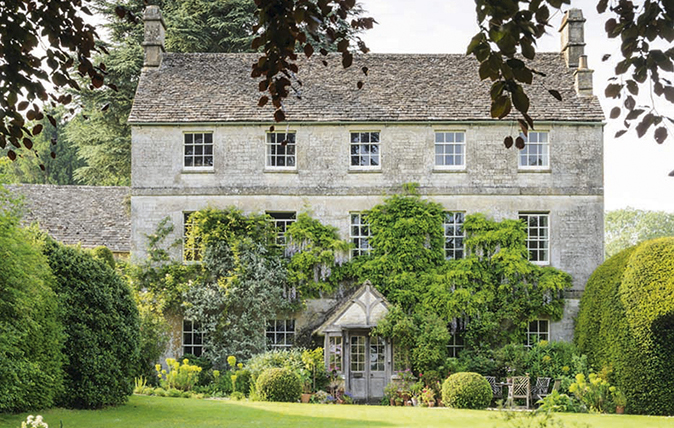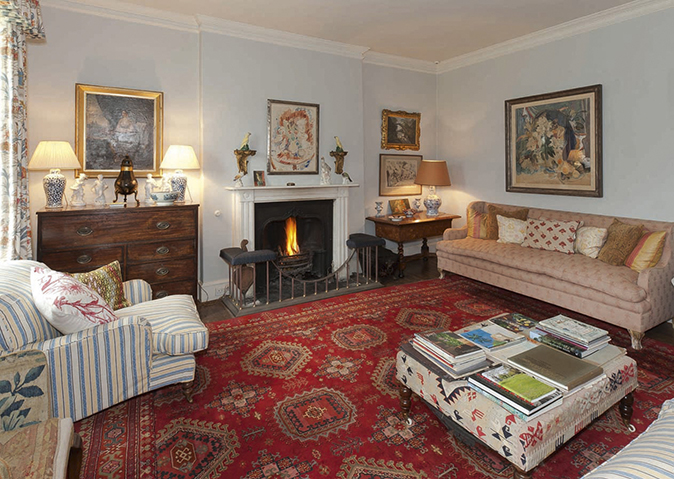Garden designer Mary Keen’s Cotswold home goes on the market
A gardener’s garden.


For Sam Trounson of Strutt & Parker (01285 627680), The Old Rectory at Duntisbourne Rouse, near Cirencester, Gloucestershire, is every country-house agent’s dream—a classic Georgian former rectory, set in 22 acres of gardens, paddocks and woodland in a delightfully unspoilt hamlet in the heart of the Cotswolds. For Mr Trounson, what makes this very English house, with its unique Cotswold gardens, so special is its ‘comfortably timeless appeal, with no pretensions whatever to fashionable chic’.
The Old Rectory’s charm has long been recognised by admirers of the Duntisbournes, a group of tiny villages and hamlets described by the late writer Candida Lycett Green as lying in ‘deep, little-visited Cotswold country’, yet only four miles from Cirencester. The approach to these ancient settlements is ‘a narrow road that trickles along the western ridge of a small, magical valley where the silvery stone walls on either side give way to high white walls of thorn blossom, before looping precipitously down to Middle Duntisbourne’ and its neighbour Duntisbourne rouse.
Originally built in about 1830 with later additions, The old rectory, listed Grade II, stands next to the pretty church of St Michael, listed Grade I, thanks largely to the intervention, in the 1930s, of the architect Sidney Gambier-Parry, who, on moving to ‘the tall, unpretentious rectory hard by’, found the church in a state of disrepair and set about restoring it. Since then, little has changed in this valley and, according to Mrs Lycett Green, ‘St Michaels remains well loved and the present rectory dwellers, whose brilliant vegetable garden skirts the western churchyard wall, are devoted custodians’.

Those ‘custodians’ are legendary garden designer and writer Mary Keen and her husband, Charles, who, over the years, have toiled ceaselessly to create their own gloriously unpretentious corner of the Cotswolds— a two-acre garden ‘tipping into wilderness’ and surrounded by 10 acres of pasture and eight acres of woodland. Writing in Country Life (September 9, 2015), Lady Mary reveals a down-to-earth approach to her own, very private, rectory garden—quite different, she admits, from the more formal gardens that she and her associate Pip Morrison are called upon to design for an eclectic international clientele. ‘With almost two acres and only five days a month of skilled help, it’s important to be realistic about what can be done once one is past the age of three-score years and 10,’ she explains. ‘It helps that I prefer creating atmosphere to fussing over tidy perfection, but I do want energy to spare for tending auriculas, pelargoniums, annual and half-hardies, as well as greenhouse work.’
High horticulture just can’t happen everywhere,’ continues Lady Mary. ‘Topiary and paths and edges are trim, but self-heal and plenty of moss grows on the lawn. We do stake and dead-head the grander plants and I’m thinking about Chelsea-chopping the phlox next year, which might save a bit of time. Watering on our dry soil is demanding and I find it hard to resist pots, deployed around the front and back doors and along the side of the house. None of this is sensible, but, until it ceases to be enjoyable, I will carry on. I still enjoy the imperfections, the struggle to make a garden work. I think one of the things all gardeners should remember is that making a garden is a process and there’s never a finished product.’
All sound advice that will no doubt resonate with the next owners of this magical place, now that the Keens have found a house that they want to move to and are about to call time on their beloved Old Rectory. Whether or not the next incumbents will share their passion for gardening remains to be seen, but, with more than 20 acres to play with, there’s still much that will appeal to a younger generation of country lovers.
With 4,435sq ft of living space, including two main reception rooms, a study, six bedrooms and three bath- rooms in the three-storey main house, plus the two-bedroom Dunt cottage converted from a former stable block and a second detached cottage converted from the original village school, The Old Rectory can accommodate almost any configuration of family members. And with schools such as Beaudesert Park, Rendcomb and the Cheltenham colleges within easy reach, the cities of Bath, Bristol, Gloucester and Oxford within daily commuting distance and London readily accessible from Kemble station, this rare Cotswold property, in its own unpretentious way, offers the best of everything the region has to offer.
Sign up for the Country Life Newsletter
Exquisite houses, the beauty of Nature, and how to get the most from your life, straight to your inbox.
-
 The King's favourite tea, conclave and spring flowers: Country Life Quiz of the Day, April 22, 2025
The King's favourite tea, conclave and spring flowers: Country Life Quiz of the Day, April 22, 2025Tuesday's Quiz of the Day blows smoke, tells the time and more.
By Toby Keel Published
-
 London is the place for me* (*the discerning property buyer)
London is the place for me* (*the discerning property buyer)With more buyers looking at London than anywhere else, is the 'race for space' finally over?
By Annabel Dixon Last updated
